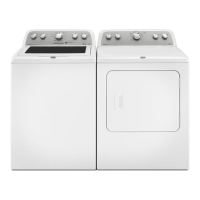3
WHAT’S NEW UNDER THE LID?
Choosing the Right Detergent
Use only High Efficiency detergents. The package will be
marked “HE” or “High Efficiency.” Low-water washing creates
excessive sudsing with a regular non-HE detergent. Using regular
detergent will likely result in longer cycle times and reduced
rinsing performance. It may also result in component failures and
noticeable mold or mildew. HE detergents are made to produce
the right amount of suds for the best performance. Follow the
manufacturer’s instructions to determine the amount of detergent
to use and do not go over the Max line. See “Using Laundry
Product Dispensers” for more information.
Normal Sounds You Can Expect
At different stages of the wash cycle, you may hear sounds and
noises that are different from those of your previous washer. For
example, you may hear a clicking and hum at the beginning of the
cycle as the lid lock goes through a self-test. There will be different
kinds of humming and whirring sounds as the washplate moves the
load and as the basket is decelerating to a stop. And sometimes,
you may hear nothing at all as the washer determines the correct
water level for your load or allows time for clothes to soak.
Use only High Efficiency (HE) detergent.
Improved Cleaning
Low-water cleaning means concentrated cleaning. Rather than
diluting detergent as done in an agitator-style washer, this washer
delivers the detergent directly to the soils. This low water wash also
allows the clothing to move in a more effective way to remove soils.
Cleaning with Less Water
The most striking difference in your new washer is the low-water
washplate wash system. The washer automatically adjusts the
water level to the load size—no water level selector is needed.
Traditional agitator-style
washer
Washer with low-water wash-
plate wash system
Washplate
Automatic Load Size Sensing
Once you start the cycle, the lid will lock, and the washer will begin
the sensing process to determine the correct water level for the
load. This may take several minutes before water is added. You will
find a step-by-step description in the “Cycle Status Lights” section.
Initially the basket will start to spin prior to adding water. This is part
of the sensing process and is normal. This low-water wash method
uses less water and energy compared to a traditional agitator-style
washer.
As the washer dampens and moves the load, the level of the items
will settle in the basket. This is normal and does not indicate that
more items should be added.
IMPORTANT: You will not see a washer basket full of water
as with your past agitator-style washer. It is normal for some
of the load to be above the water line.
For best performance, it is recommended to load items in loose
heaps evenly around the washplate.

